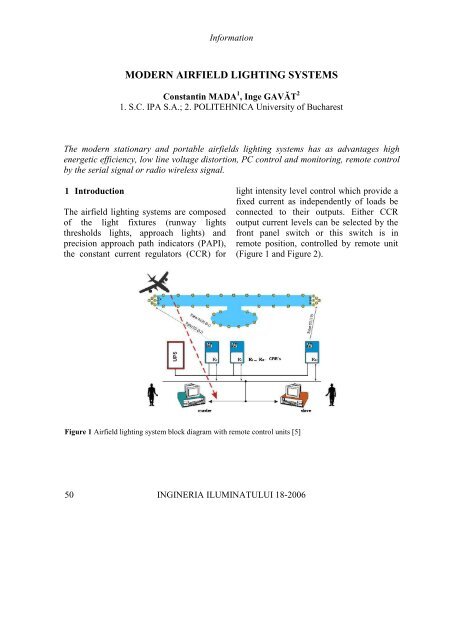This issue is sponsored by the Philips Romania, Lighting Division
This issue is sponsored by the Philips Romania, Lighting Division
This issue is sponsored by the Philips Romania, Lighting Division
Create successful ePaper yourself
Turn your PDF publications into a flip-book with our unique Google optimized e-Paper software.
50<br />
Information<br />
MODERN AIRFIELD LIGHTING SYSTEMS<br />
Constantin MADA 1 , Inge GAVĂT 2<br />
1. S.C. IPA S.A.; 2. POLITEHNICA University of Bucharest<br />
The modern stationary and portable airfields lighting systems has as advantages high<br />
energetic efficiency, low line voltage d<strong>is</strong>tortion, PC control and monitoring, remote control<br />
<strong>by</strong> <strong>the</strong> serial signal or radio wireless signal.<br />
1 Introduction<br />
The airfield lighting systems are composed<br />
of <strong>the</strong> light fixtures (runway lights<br />
thresholds lights, approach lights) and<br />
prec<strong>is</strong>ion approach path indicators (PAPI),<br />
<strong>the</strong> constant current regulators (CCR) for<br />
Figure 1 Airfield lighting system block diagram with remote control units [5]<br />
INGINERIA ILUMINATULUI 18-2006<br />
light intensity level control which provide a<br />
fixed current as independently of loads be<br />
connected to <strong>the</strong>ir outputs. Ei<strong>the</strong>r CCR<br />
output current levels can be selected <strong>by</strong> <strong>the</strong><br />
front panel switch or th<strong>is</strong> switch <strong>is</strong> in<br />
remote position, controlled <strong>by</strong> remote unit<br />
(Figure 1 and Figure 2).
















